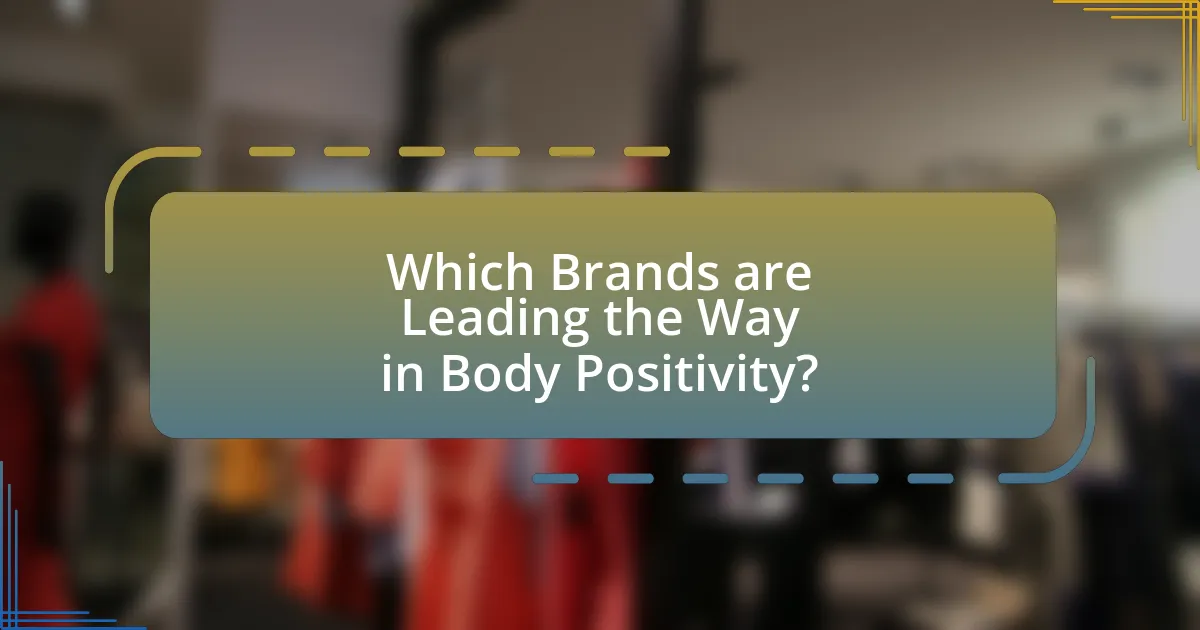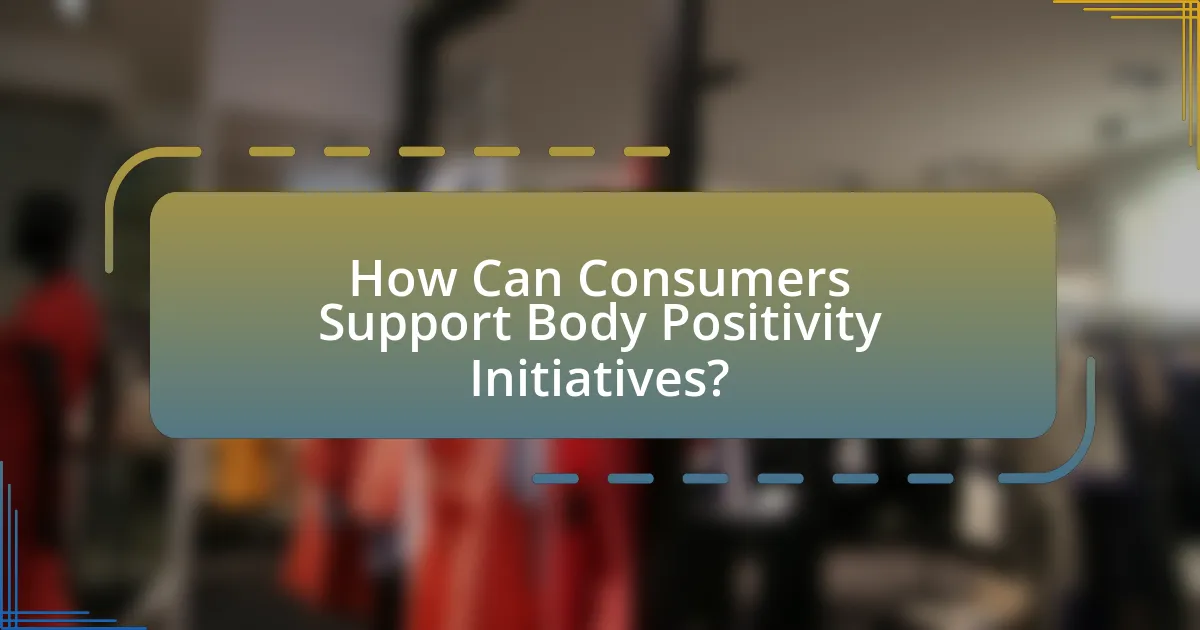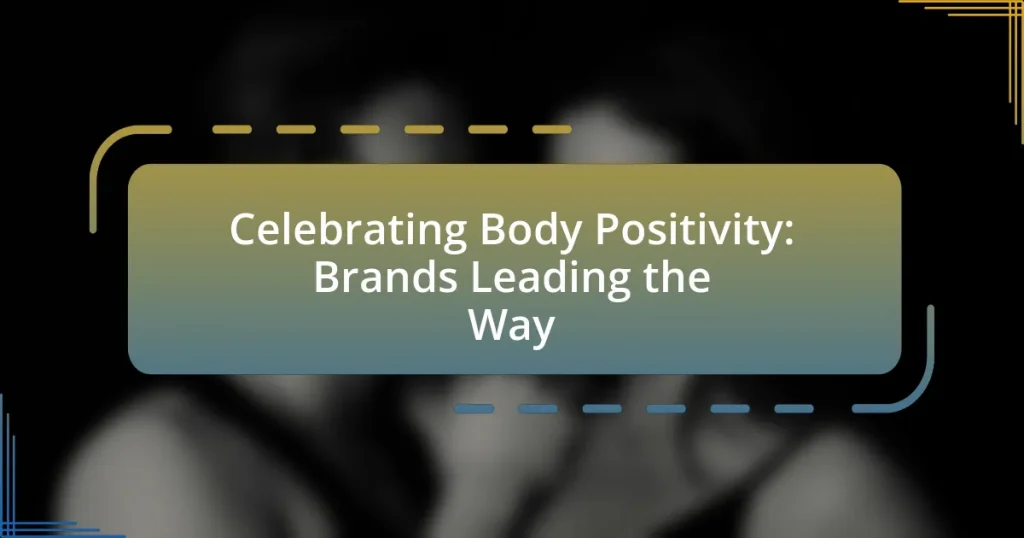Body positivity is a social movement advocating for the acceptance of all body types, emphasizing self-love and confidence while challenging societal beauty standards. The article explores the origins of the Body Positivity Movement, its historical influences, and key figures who have shaped its narrative. It highlights the core principles of body positivity, its impact on mental health, and the role of inclusivity in promoting diverse representations. Additionally, the article examines brands leading the way in body positivity, their marketing strategies, and the challenges they face, while also providing insights on how consumers can support and engage with body positivity initiatives.

What is Body Positivity and Why is it Important?
Body positivity is a social movement advocating for the acceptance of all body types, promoting the idea that individuals should feel confident and comfortable in their own skin, regardless of societal standards of beauty. This movement is important because it challenges harmful stereotypes and promotes mental health by reducing body shaming and fostering self-love. Research indicates that body positivity can lead to improved self-esteem and overall well-being, as evidenced by a study published in the journal “Body Image,” which found that individuals who embrace body positivity experience lower levels of body dissatisfaction and higher levels of life satisfaction.
How did the Body Positivity Movement begin?
The Body Positivity Movement began in the late 1960s as a response to societal standards of beauty that marginalized individuals based on their body size and shape. It was initially rooted in the fat acceptance movement, which sought to challenge the stigma associated with larger bodies and promote self-acceptance. The movement gained momentum through various platforms, including social media, where individuals shared their experiences and advocated for diverse representations of body types. This grassroots activism has led to increased visibility and support for body diversity, influencing brands to adopt more inclusive marketing strategies.
What historical events contributed to the rise of Body Positivity?
The rise of Body Positivity was significantly influenced by the feminist movements of the 1960s and 1970s, which challenged traditional beauty standards and advocated for women’s rights and self-acceptance. These movements laid the groundwork for a broader acceptance of diverse body types by promoting the idea that all bodies deserve respect and love, regardless of size or shape. Additionally, the emergence of the fat acceptance movement in the late 20th century further propelled Body Positivity by directly confronting societal stigma against larger bodies, emphasizing health at every size and the importance of self-love. Events such as the establishment of the National Association to Advance Fat Acceptance in 1969 and the publication of influential works like “The Beauty Myth” by Naomi Wolf in 1990 provided critical platforms for these discussions, reinforcing the validity of Body Positivity as a social movement.
Who are the key figures in the Body Positivity Movement?
Key figures in the Body Positivity Movement include activists and influencers such as Ashley Graham, who is known for advocating for body diversity in the fashion industry, and Lizzo, who promotes self-love and acceptance through her music and public persona. Additionally, Tess Holliday has gained recognition for her work in challenging beauty standards and promoting inclusivity. These individuals have significantly impacted the movement by using their platforms to raise awareness about body image issues and encourage acceptance of all body types.
What are the core principles of Body Positivity?
The core principles of Body Positivity include acceptance of all body types, challenging societal beauty standards, and promoting self-love and confidence. Acceptance emphasizes that every body is unique and deserving of respect, regardless of size, shape, or appearance. Challenging societal beauty standards involves questioning and rejecting narrow definitions of beauty that often marginalize individuals. Promoting self-love and confidence encourages individuals to appreciate their bodies and foster a positive self-image. These principles aim to create an inclusive environment that celebrates diversity and combats body shaming, ultimately contributing to improved mental health and well-being.
How does Body Positivity challenge societal beauty standards?
Body positivity challenges societal beauty standards by promoting the acceptance of diverse body types and rejecting the narrow definitions of beauty often perpetuated by media and culture. This movement encourages individuals to embrace their bodies regardless of size, shape, or appearance, thereby undermining the traditional ideals that often prioritize thinness and specific physical attributes. Research indicates that body positivity can lead to improved mental health outcomes, as it fosters self-acceptance and reduces the stigma associated with non-conforming bodies. For instance, a study published in the journal “Body Image” found that individuals who engage with body-positive content report higher levels of body satisfaction and lower levels of disordered eating behaviors.
Why is inclusivity essential in the Body Positivity Movement?
Inclusivity is essential in the Body Positivity Movement because it ensures that individuals of all body types, sizes, and backgrounds feel represented and valued. This representation fosters a sense of belonging and acceptance, which is crucial for combating societal beauty standards that often marginalize certain groups. Research indicates that diverse representation in media and advertising positively impacts self-esteem and body image among underrepresented populations, as seen in studies published by the Journal of Health Psychology, which highlight the psychological benefits of seeing diverse body types in mainstream media. Therefore, inclusivity not only broadens the movement’s reach but also enhances its effectiveness in promoting overall body acceptance and mental well-being.
What impact does Body Positivity have on mental health?
Body positivity significantly enhances mental health by promoting self-acceptance and reducing feelings of shame associated with body image. Research indicates that individuals who embrace body positivity experience lower levels of anxiety and depression, as they are less likely to engage in negative self-talk and body dissatisfaction. A study published in the journal “Body Image” found that participants who practiced body positivity reported higher self-esteem and overall life satisfaction, demonstrating a clear link between body acceptance and improved mental well-being.
How can Body Positivity improve self-esteem?
Body positivity can improve self-esteem by fostering a more accepting and loving attitude towards one’s body, which reduces negative self-perception. When individuals embrace body positivity, they often experience a shift in mindset that encourages self-acceptance and appreciation for their unique physical attributes. Research indicates that individuals who engage with body-positive messages report higher levels of self-esteem and body satisfaction. For instance, a study published in the journal “Body Image” found that participants exposed to body-positive content showed significant improvements in self-esteem compared to those who were not. This correlation highlights the effectiveness of body positivity in enhancing self-worth and promoting a healthier self-image.
What role does Body Positivity play in combating body shaming?
Body positivity plays a crucial role in combating body shaming by promoting acceptance and appreciation of diverse body types. This movement encourages individuals to embrace their bodies, regardless of societal standards, thereby reducing the stigma associated with different appearances. Research indicates that body positivity can lead to improved self-esteem and mental health, which are essential in countering the negative effects of body shaming. For instance, a study published in the journal “Body Image” found that individuals who engage with body-positive content report lower levels of body dissatisfaction and a greater sense of self-worth. By fostering a culture of inclusivity and self-love, body positivity actively challenges the harmful narratives that fuel body shaming.

Which Brands are Leading the Way in Body Positivity?
A few brands leading the way in body positivity include Aerie, Savage X Fenty, and Dove. Aerie, a lingerie brand, has gained recognition for its #AerieREAL campaign, which promotes unretouched photos of models, emphasizing authenticity and inclusivity. Savage X Fenty, founded by Rihanna, showcases diverse body types in its fashion shows and campaigns, celebrating all shapes and sizes. Dove has long been an advocate for body positivity through its Real Beauty campaign, which challenges traditional beauty standards and promotes self-esteem among women. These brands have made significant impacts by prioritizing representation and challenging societal norms regarding body image.
What are some notable brands that promote Body Positivity?
Notable brands that promote body positivity include Aerie, Dove, and Savage X Fenty. Aerie, a lingerie brand, has gained recognition for its #AerieREAL campaign, which features unretouched photos of models of diverse body types. Dove, known for its personal care products, launched the Dove Campaign for Real Beauty, which emphasizes the beauty of all body shapes and sizes, supported by research showing that only 4% of women consider themselves beautiful. Savage X Fenty, founded by Rihanna, showcases a wide range of sizes and promotes inclusivity in its fashion shows, celebrating body diversity. These brands actively challenge traditional beauty standards and advocate for self-acceptance.
How do these brands incorporate Body Positivity into their marketing strategies?
Brands incorporate body positivity into their marketing strategies by featuring diverse body types in their advertising campaigns. For instance, companies like Aerie and Dove have utilized real customers and models of various sizes, shapes, and ethnicities to promote inclusivity and challenge traditional beauty standards. Aerie’s #AerieREAL campaign, which showcases unretouched photos of models, has led to a significant increase in sales, demonstrating the effectiveness of this approach. Similarly, Dove’s “Real Beauty” campaign, launched in 2004, has been pivotal in reshaping perceptions of beauty, resulting in a 700% increase in brand sales over the years. These strategies not only resonate with consumers but also foster a sense of community and acceptance, reinforcing the brands’ commitment to body positivity.
What products or services do these brands offer that align with Body Positivity?
Brands that align with Body Positivity offer inclusive clothing lines, diverse beauty products, and wellness services that celebrate all body types. For instance, clothing brands like Aerie and Savage X Fenty provide a wide range of sizes and promote body diversity in their marketing campaigns. Additionally, beauty brands such as Fenty Beauty offer a broad spectrum of shades to cater to all skin tones, reinforcing the message that beauty comes in various forms. Wellness services, including body-positive fitness programs, focus on health and self-acceptance rather than weight loss, further supporting the body positivity movement. These offerings collectively challenge societal norms and encourage individuals to embrace their unique bodies.
How do these brands engage with their audiences on Body Positivity?
Brands engage with their audiences on Body Positivity by promoting inclusive messaging, showcasing diverse body types in their marketing campaigns, and fostering community through social media platforms. For instance, brands like Aerie and Dove have launched campaigns that feature real customers of various sizes and backgrounds, which resonate with their audience and encourage self-acceptance. Aerie’s #AerieREAL campaign, which features unretouched photos of models, has significantly increased brand loyalty and sales, demonstrating the effectiveness of authentic representation. Additionally, these brands often collaborate with body positivity advocates and influencers to amplify their message, creating a supportive environment that encourages dialogue around body image issues.
What social media strategies do these brands use to promote Body Positivity?
Brands promote body positivity on social media through inclusive campaigns, user-generated content, and partnerships with diverse influencers. Inclusive campaigns feature models of various body types, showcasing real people rather than traditional beauty standards, which helps to normalize diverse appearances. User-generated content encourages followers to share their own body positivity stories, fostering community engagement and authenticity. Additionally, partnerships with diverse influencers amplify these messages, as they resonate with a broader audience and provide relatable representation. For instance, brands like Aerie and Dove have successfully utilized these strategies, leading to increased brand loyalty and positive consumer perception.
How do customer testimonials reflect the brands’ commitment to Body Positivity?
Customer testimonials reflect brands’ commitment to body positivity by showcasing real experiences and diverse body representations that resonate with consumers. These testimonials often highlight how products empower individuals to embrace their unique bodies, reinforcing the brand’s message of inclusivity. For instance, brands like Aerie and Dove have utilized customer stories that celebrate various body types, demonstrating their dedication to promoting self-acceptance and challenging traditional beauty standards. This alignment with customer values not only strengthens brand loyalty but also positions the brands as advocates for body positivity in the marketplace.
What challenges do brands face in promoting Body Positivity?
Brands face significant challenges in promoting body positivity, primarily due to societal beauty standards and consumer skepticism. Societal beauty standards often dictate narrow definitions of attractiveness, making it difficult for brands to authentically represent diverse body types without facing backlash. Additionally, consumer skepticism arises from past instances where brands have been accused of “performative activism,” leading audiences to question the sincerity of their body positivity campaigns. Research indicates that 67% of consumers believe brands should take a stand on social issues, yet they also demand genuine commitment rather than superficial marketing tactics. This dual pressure complicates brands’ efforts to navigate the body positivity movement effectively.
How do brands navigate backlash or criticism related to Body Positivity?
Brands navigate backlash or criticism related to Body Positivity by actively engaging with their audience, addressing concerns transparently, and adapting their messaging to reflect inclusivity. For instance, when faced with criticism, brands often issue public statements acknowledging the feedback and outlining steps they will take to improve representation. A notable example is Aerie, which faced backlash for its initial marketing strategies but responded by promoting unretouched images of diverse body types, resulting in a 20% increase in sales in 2019. This approach not only mitigates negative perceptions but also fosters a community that values authenticity and inclusivity, demonstrating that brands can successfully turn criticism into an opportunity for growth and connection.
What are the risks of tokenism in Body Positivity marketing?
Tokenism in Body Positivity marketing risks undermining the authenticity of the movement and alienating the very audience it aims to support. When brands feature diverse body types superficially, without genuine commitment to inclusivity, they can perpetuate stereotypes and reinforce societal beauty standards. For instance, a study by the University of California found that token representation can lead to backlash from consumers who perceive the marketing as insincere or exploitative. This can damage brand reputation and erode trust among consumers who value authenticity and meaningful representation.

How Can Consumers Support Body Positivity Initiatives?
Consumers can support body positivity initiatives by actively choosing to engage with brands that promote diverse body representations and inclusive messaging. By purchasing products from companies that feature models of various sizes, shapes, and backgrounds, consumers contribute to a market demand for body diversity. Research indicates that 67% of consumers prefer brands that reflect a range of body types in their advertising, demonstrating the impact of consumer choices on brand practices. Additionally, sharing and promoting body-positive content on social media amplifies these initiatives, fostering a community that values self-acceptance and diversity.
What actions can consumers take to promote Body Positivity?
Consumers can promote body positivity by actively supporting brands that embrace diverse body types and inclusive messaging. By choosing to purchase from companies that prioritize body diversity in their marketing and product offerings, consumers help shift industry standards towards acceptance and representation. Research indicates that brands showcasing a range of body types can positively influence consumer perceptions and self-esteem, as seen in studies by the University of California, which found that diverse representation in advertising leads to increased body satisfaction among viewers. Additionally, consumers can engage in social media campaigns that advocate for body positivity, share personal stories, and challenge harmful beauty standards, further amplifying the message of acceptance and self-love.
How can consumers choose brands that align with Body Positivity values?
Consumers can choose brands that align with Body Positivity values by researching companies that promote diverse body representations in their marketing and product offerings. Brands that feature models of various sizes, shapes, and ethnicities in their advertising campaigns demonstrate a commitment to inclusivity. Additionally, consumers should look for brands that actively support body positivity initiatives, such as partnerships with organizations that advocate for self-acceptance and mental health. For instance, brands like Aerie and Savage X Fenty have been recognized for their body-positive messaging and inclusive sizing, which reinforces their alignment with these values.
What role does advocacy play in supporting Body Positivity?
Advocacy plays a crucial role in supporting Body Positivity by promoting acceptance of diverse body types and challenging societal beauty standards. Through campaigns, social media movements, and public discussions, advocacy raises awareness about the negative impacts of body shaming and discrimination. For instance, organizations like the Body Positive and campaigns such as #EffYourBeautyStandards have successfully mobilized communities to embrace body diversity, leading to increased visibility and representation in media. This collective effort fosters a culture of inclusivity, encouraging individuals to appreciate their bodies and reducing stigma associated with non-conforming body types.
How can individuals contribute to a culture of Body Positivity?
Individuals can contribute to a culture of Body Positivity by promoting acceptance of diverse body types and challenging societal beauty standards. By sharing their own body stories and experiences on social media, individuals can foster a sense of community and support for others who may struggle with body image issues. Research indicates that positive body image can be enhanced through social support and representation, as seen in studies published in the Journal of Health Psychology, which highlight the impact of body diversity in media on self-esteem. Additionally, individuals can engage in conversations that emphasize self-love and body acceptance, thereby normalizing these values in their social circles.
What are some practical tips for fostering Body Positivity in daily life?
To foster body positivity in daily life, individuals can practice self-affirmation by regularly acknowledging and appreciating their unique qualities and strengths. This approach is supported by research indicating that positive self-affirmations can enhance self-esteem and reduce negative body image perceptions. Additionally, surrounding oneself with supportive and body-positive communities can reinforce healthy attitudes towards body image, as social influences significantly impact self-perception. Engaging in activities that promote physical well-being, such as exercise for enjoyment rather than weight loss, can also contribute to a more positive body image. Studies show that focusing on the joy of movement rather than appearance leads to improved mental health outcomes. Lastly, critically evaluating media consumption and choosing body-positive content can help counteract harmful societal standards, as exposure to diverse body representations has been linked to increased body satisfaction.
How can community involvement enhance Body Positivity efforts?
Community involvement can enhance Body Positivity efforts by fostering a supportive environment that encourages acceptance and diversity in body shapes and sizes. When communities actively participate in Body Positivity initiatives, they create platforms for sharing personal stories and experiences, which can reduce stigma and promote understanding. Research indicates that social support is crucial for improving self-esteem and body image; for instance, a study published in the Journal of Health Psychology found that individuals who engage in supportive community activities report higher levels of body satisfaction. Additionally, community events, workshops, and campaigns can raise awareness and educate members about the importance of body diversity, further reinforcing positive attitudes towards all body types.
What resources are available for those interested in Body Positivity?
Resources available for those interested in Body Positivity include online communities, social media platforms, literature, and workshops. Online communities such as the Body Positive and the Fat Acceptance Movement provide support and information. Social media platforms like Instagram and TikTok feature influencers and activists who promote body positivity through engaging content. Literature, including books like “The Body Is Not an Apology” by Sonya Renee Taylor, offers insights and strategies for embracing body positivity. Workshops and events, often organized by local organizations or online platforms, provide interactive experiences to foster body acceptance and self-love. These resources collectively contribute to a growing movement that encourages individuals to celebrate their bodies and challenge societal beauty standards.
Where can individuals find educational materials on Body Positivity?
Individuals can find educational materials on Body Positivity through various online platforms, including websites dedicated to mental health, body image advocacy organizations, and social media channels. Notable resources include the National Eating Disorders Association (NEDA), which offers articles and toolkits on body positivity, and the Body Positive organization, which provides workshops and educational content. Additionally, social media platforms like Instagram and TikTok feature influencers and educators who share insights and resources related to body positivity, making information accessible to a wider audience.
What online communities support Body Positivity discussions?
Online communities that support Body Positivity discussions include platforms like Instagram, Reddit, and Facebook groups dedicated to body positivity. Instagram features hashtags such as #BodyPositivity and #EffYourBeautyStandards, which foster a supportive environment for sharing personal stories and images. Reddit hosts subreddits like r/bodypositivity, where users engage in discussions and share resources related to body acceptance. Facebook groups, such as “Body Positive Warriors,” provide a space for members to connect, share experiences, and promote self-love. These platforms collectively create a vibrant network for individuals to discuss and celebrate body positivity.














